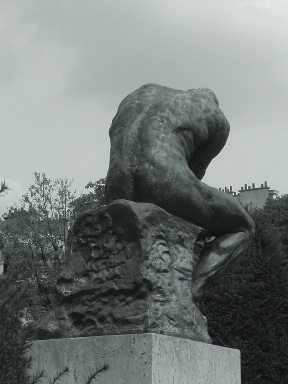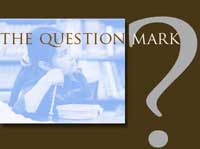The above photographs of Rodin’s Thinker are the obvious clichéd, frontal and profile views . Visitors repeatedly capture these snapshots. Few step around to show the back, the straining torso, or the rear view.
 Much thinking proceeds with the same limited perspective and limited view of reality. One must learn to step around and consider all the angles.
Much thinking proceeds with the same limited perspective and limited view of reality. One must learn to step around and consider all the angles.
Can we establish habits of mind that tilt toward the unusual perspective, reward walking about and looking askance?
Pondering?
Is he wondering what he needs to know?
Or is he capable of the “lateral thinking” we explored in the previous chapter — the ability to step out of the box of conventional wisdom to consider fresh possibilities?
When we don’t know what we don’t know, it is quite difficult to explore the unknown, in part because it is off the radar and out of sight.
“Out of sight is out of mind.”
But the most promising mental territory may be that uncovered by the seemingly irrelevant question.
The irrelevant question is a peculiar member of the Questioning Toolkit outlined in Chapter 9 of this book. Its power is counter-intuitive and its practice is rare.
One must learn to escape from the limitations of conventional wisdom and thinking by ranging farther afield. In fact, this kind of exploration requires dramatic excursions into unfamiliar terrain.
One learns to walk around the statue.
Truth rarely appears where we might look logically. The creation of new knowledge almost always requires some wandering off course. The more we cling to coastline, the less apt we are to find the New World.
2. A Bridge to What We Need to Know
How do we build a bridge from what we know to what we need to know? What strategies allow us to penetrate the fog, sailing through darkness to emerge with increased understanding?
Strategy One: The Jigsaw Puzzle, Juxtaposition, and Worst Case Scenarios
 We can use the jigsaw puzzle as a metaphor for this kind of thinking. Faced with a pile of a thousand landscape pieces, we hardly know where to begin, but after we gather edges and begin to fill in a few sections, what is missing begins taking form in contrast to what is found.
We can use the jigsaw puzzle as a metaphor for this kind of thinking. Faced with a pile of a thousand landscape pieces, we hardly know where to begin, but after we gather edges and begin to fill in a few sections, what is missing begins taking form in contrast to what is found.
Extend this metaphor to a cluster diagram. First we map what we know on the left side of a cluster diagram. We then create a matching set of empty boxes on the right as unknowns.
Making plans without paying attention to what might possibly go wrong is dangerous - the equivalent of wishful thinking.
Using the juxtaposition strategy, the diagram would be augmented to force consideration of disappointments and obstacles. The two columns on the right ask important questions.
What could go wrong?
What have we overlooked?
Anticipating problems, obstacles and hurdles strengthens the planning process and reduces the chances of failure.
Some planners call this process scenario-building. The goal is to spin out an array of situations that might arise despite our best hopes and efforts — scenarios ranging from optimistic and provident to disastrous. Smart planners include at least one “worst case scenario” in their preparations so that they have strategies in mind to protect them against the dark side of life.
Strategy Two: Reversal
Turn the issue, problem or challenge upside down and inside out. Take the issue, problem or challenge and spin it about to look at all the different angles. If black, look at the white or blue.
Planning to install a new reading program? Consider removal of a reading program, a step usually overlooked when introducing something new. Introducing an after school program? Consider a morning substitute. Trying to cut down on the incidence of anti-social behaviors?
Give thought to increasing the frequency of good deeds and good works.
While each of these are a matter of words, semantics and emphasis, these mental frameworks can have a deciding impact on the way a challenge is approached and change is made.
Strategy Three: Grab the Tail
When caught on the horns of a dilemma, grab the tail!
Classic problem-solving strategies abound for those who are stuck in their planning. In all too many cases, we fixate on a few options and fail to invest adequately in spinning out options. We narrow choices too rapidly and then agonize over the resulting scarcity of possibilities. Many organizations rush to deal with symptoms of problems rather than root causes. Later they lament the failure of policy.
The folk wisdom of grabbing the tail captures the essence of both.
Strategy Four: Theater of the Absurd and Beyond the Pale
While it would be nice if the human behavior and the nature of life were logical, reasonable and sensible, much is irrational and very strange. Logical and sensible people sometimes have difficulty thinking illogically, so they are limited in their ability to contend with illogical forces, extremists and highly emotional opponents.
playwrights like Samuel Beckett, Eugene Ionesco, Jean Genet and Harold Pinter coined the term theater of the absurd in the 1950s.
Planners who limit their thinking and their reading to like minded thinkers and planners are unlikely to understand the thinking of irrational opponents, insurgents, seers, prophets and demagogues. Unpleasant as it might seem, we must all extend our reading, our listening and our thinking to penetrate the veils and walls surrounding the dreams, wishes, lies, plans and strategies of those who live, think, operate and act beyond the pale.
If we never read what dissidents and radicals are writing and thinking, we are likely to wake up to unthinkable headlines when they take actions that seem horrific. If we surround ourselves with true believers of our own faith, we may make very poor chess players when face to face with those of different persuasions.
To avoid horrific surprises, we must extend our definitions of intelligence to include the search for the radical, the absurd and the illogical. Rather than suppressing all media that lie beyond the pale, we might sometimes pay attention to some of the laments, the threats and the rallying cries.
Counter insurgency without deep knowledge of an opponent is a good example of theater of the absurd posing as rational policy.
Strategy Five: Taking Soundings and Mapping the Unknown
Long before Captain James Cook appeared on the scene, Pacific Islanders had been sailing hundreds of miles of open ocean between islands using quite complicated navigational systems to find their way. Relying upon constellations, currents and many natural clues, they were able to travel far and still find their way home.
Captain Cook devoted much of his career to carefully charting on paper those regions of the world that had not yet been charted (in European terms. With his collection of charts drawn by other European explorers and the help of Pacific Islanders, he set about filling in the missing regions by sailing into them to see if there were land forms worthy of charting.
When sailing into a harbor unknown to Europeans, a member of his crew routinely used a lead to take soundings (judge the depth of the water). These were added to the chart as one more measure of the world being described.
The construction of knowledge and especially the discovery of new ideas and possibilities must also proceed by venturing, sounding and mapping.




 Much thinking proceeds with the same limited perspective and limited view of reality. One must learn to step around and consider all the angles.
Much thinking proceeds with the same limited perspective and limited view of reality. One must learn to step around and consider all the angles. We can use the jigsaw puzzle as a metaphor for this kind of thinking. Faced with a pile of a thousand landscape pieces, we hardly know where to begin, but after we gather edges and begin to fill in a few sections, what is missing begins taking form in contrast to what is found.
We can use the jigsaw puzzle as a metaphor for this kind of thinking. Faced with a pile of a thousand landscape pieces, we hardly know where to begin, but after we gather edges and begin to fill in a few sections, what is missing begins taking form in contrast to what is found.